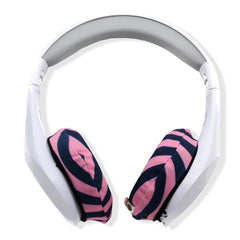How Can I Protect My Headphones from Damage?

Our headphones are vulnerable to damage.
They take a real battering throughout the day. We wear them when we’re commuting, exercising, learning and relaxing. Some of us take them everywhere with us. There was a time when big headphones stayed at home close to the stereo system but now it’s common to see them in gyms, lecture halls, gaming cafes or worn on planes and trains.
People wear them walking down the street or when they’re working from a cubical or an open-plan office. Headphones have become a huge part of our identity; they help us to connect to the world around us and, when we need to, help us to cut off from it, too. It’s important to protect them.
Whether you’ve dropped £50 or £1500 on a pair, we all want the tech we buy to last.
But our headphones are tested each time we wear them. The headband flexes. The earpad cushions stretch. We expose the pads to UV light, facial oils, sweat, dirt, make-up, and dust.
Sometimes manufacturing weaknesses create problems: poor quality materials or a bad batch. Our own carelessness can create problems, too. We forget how delicate technology can be.
Anyone who’s ever had wired earphones will remember the frustration of that one dodgy speaker caused by a twisted or fraying internal wire. But what can you do?
We’re going to go through some of the main ways that you can protect your headphones from damage.
How Can I Protect My Headphones from Damage?
1. Keep your headphones in a case when you’re traveling. Premium brands will often supply one with your purchase but these may not also be to your taste nor will they always be suitable to your lifestyle. Buy one you’ll use. Cases provide a measure of protection. Hard-shell cases are useful if you think your headphones are at risk of external breaking. Cases also protect from dirt and dust. They also protect against UV damage which is particularly important if you have white headphones as sunlight can bleach them yellow. Carry cases can also ensure that the wire is secure and protected, too.
2. Sweat can damage headphones and shorten the lifespan of your product. Wiping down your headphones after extended periods of wear helps reduce any corrosion of the earpads. This is especially important if you sweat heavily or if you’re exercising in them.
Sweat-resistant headphone covers are best for ensuring your earpads remain looking and smelling fresh. Moisture can degrade the plastic leather of the cushions leading to flaking, peeling and cracking of the material that looks awful and will smell even less so.
GymHugz has a range of machine-washable headphone covers in a range of great designs (all of which can be reversed). It uses sweat-wicking material – the same as you’ll see on athletes and sports stars. Sweat-wicking doesn’t just prevent moisture from getting to the headphone, it also aids in the evaporation process so you’ll stay cooler and more comfortable for longer.
Covers will also help keep the cushions clean by preventing the transfer of make-up of facial oils onto the earpad. This is key to keeping white covers looking fresh and vibrant.
Some headphone manufacturers don’t factor replacement cushions into the design. This means the only option is to peel the cushion off yourself and then use adhesive to re-fix it or buy an entirely new set of headphones.
Remember, however, that removing the earpads could void your warranty. It’s far easier just to add a moisture-proof cover and crack on with your day.
3. Wires are a common cause of headphone damage. They’re vulnerable to stress, especially at the jack. A loose or broken wire can cause audio issues affecting either one or both speakers. The obvious solution is to go wireless. Audio quality has gone up with Bluetooth and price has come down. Most wireless headphones include a wire to attach when the battery is low so you can easily switch between the two. Wireless is also easier when you’re traveling and working out.
But not everyone wants to use wireless headphones. That’s fine. It just means you’ll have to be more careful especially when plugging or unplugging your headphones into your device. Always pull the jack and never the wire. How you wrap the wires after you’re done listening can also help protect your headphones from damage. You can try the roadie wrap which we mentioned in a previous post. When you’re not using wired headphones, it’s useful to store them in a carry case or in a safe place when hanging wires won’t get rolled over by an office chair or snagged in some way.
4. WikiHow advises headphones uses to keep the volume of your devices down before plugging in headphones. This prevents the loud audio from damaging the speakers. Once the headphones are plugged in, you can raise the volume to the level needed.
Much of what we’ve described above comes down to some degree of care. That can be difficult if you’re in the habit of throwing headphones into bags or down onto car seats and tables. Ensuring that you’ve bought a quality brand and model can help, too, as the manufacturing materials tend to be of higher quality, although that’s not always the case.
Keeping moisture and stains clear of your cushions is always a good idea. So is keeping your proof of purchase during the warranty period. Whilst you won’t get a replacement pair or refund for something that’s your fault (sweat damage, general wear and tear or DIY cushion replacement, for example), it can be useful for faulty wiring or audio issues.








